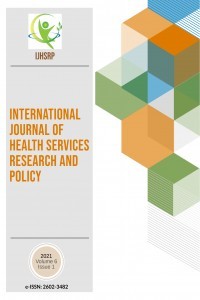INTESTINAL PARASITE INFECTIONS AND ASSOCIATED RISK FACTORS IN INHABITANTS OF THE CITY OF YAOUNDÉ, CAMEROON
INTESTINAL PARASITE INFECTIONS AND ASSOCIATED RISK FACTORS IN INHABITANTS OF THE CITY OF YAOUNDÉ, CAMEROON
Intestinal-parasite, infection-risk, inhabitants, Yaoundé, Cameroon,
___
- [1] Tigabu A., et al. "Prevalence and associated factors of intestinal parasitic infections among patients attending Shahura Health Center, Northwest Ethiopia", BMC Research Notes, 12, 1-8, 2019.
- [2] Neiderud C., "How urbanization affects the epidemiology of emerging infectious diseases", Infection Ecology and Epidemiology, 5, 1-9, 2015.
- [3] Takalkar A. et al., "Prevalence of intestinal parasitic infections amongst food handlers in hotels and restaurants in Solapur city", Indian Journal of Public Health 54(1), 47-48, 2010.
- [4] Kaferstein F. and Abdussalam M., "Food safety in the 21st century", Bulletin of the World Health Organization, 77(4), 347-351, 1999.
- [5] Ostan I., et al. "Health in equities: lower socio-economic conditions and higher incidences of intestinal parasites", BMC Public Health 7(1), 1-8, 2007.
- [6] Desalegn A., et al. "Evaluation of Intestinal Parasite Infection in Low and High Coverage of Graduated Households, Northwest Ethiopia: A Comparative-Based Cross sectional Study", Journal of Parasitology Research, 1-6, 2021.
- [7] Ayeh-Kumi P. et al., "Prevalence of intestinal parasitic infections among food vendors in Accra, Ghana", Journal of Tropical Medicine and Parasitology 32 (1) 1-8, 2009.
- [8] WHO, "Preventive chemotherapy in human helminthiasis", World Health Organization, Geneva, 2006.
- [9] WHO, "Helminth control in school-age children: a guide for managers of control programs" World Health Organization, Geneva, 2011.
- [10] Jia T. et al.,"Soil transmitted helminths reinfection after drug treatment: a systematic review and meta-analysis" Plos Neglected tropical Disease 6 (5), 1-11, 2012.
- [11] Grimes J. et al., "The relationship between water, sanitation and schistosomiasis: a systematic review and meta-analysis", PLoS Neglected Tropical Disease 8(12), 1-12, 2014.
- [12] PNLSHI, Programme national de lutte contre la schistosomiase et les helminthiases intestinales, Ministère de la santé publique du Cameroun, 2016.
- [13] Essogo A., “Croisade contre les vers intestinaux,” 2004. http://www.allafrica.com.p.1/. View at Google Scholar.
- [14] Yamssi C. et al., "Gastrointestinal nematodes among residents in Melong, Moungo Division, Littoral Region, Cameroon" Bio Med Research International 2021, 1-8, 2021.
- [15] MINDUB/CUY. Ministère de l’éducation de base/Communauté urbaine de Yaoundé. Communes et régions du Cameroun, Yaoundé, Inc, SOPECAM, 2020.
- [16] Katz N., Chaves A. and Pellegrino J. A, "Simple device for quantitative stool thick-smear technique in schistosomiasis mansoni", Revista do Instituto de Medicina Tropical de Sao Paulo 14(6), 397-400, 1972.
- [17] Johansen M. et al., "Towards improved diagnosis of zoonotic trematode infections in Southeast Asia", Advance Journal of Parasitology 73, 171-195, 2010.
- [18] Riaz M. et al., "Prevalence, risk factors, challenges, and the currently available diagnostic tools for the determination of helminths infections in human", European Journal of Inflammation 18, 1-15, 2020.
- [19] Machalaba C. et al., "Applying a One-Health Approach in Global Health and Medicine: Enhancing Involvement of Medical Schools and Global Health Centers", Annals of Global Health, 87(1) 1-11, 2021. [20] Awono-Ambene H. et al., "Soil-transmitted protozoans and helminths from market gardening sites of Yaoundé, Cameroon", Journal of Environmental Science and Public Health 4(2), 61-70, 2020.
- [21] Tabutin D. and Schoumaker B., "The demography of Sub-Saharan Africa in the 21st century: Transformations since 2000, outlook to 2050", Inc. English Population, pp. 165-286, 2020.
- [22] Tomono N. et al., "Risk factors of helminthiases among school-children in southern Thailand. Southeast Asian", Journal of Tropical Medicine and Public Health 34(2), 264-268, 2003.
- [23] Ercumen A. et al., "Effects of water, sanitation, handwashing and nutritional interventions on soil transmitted helminth infections in young children: A cluster-randomized controlled trial in rural Bangladesh", PloS Neglected Tropical Disease 13 (5), 1-24, 2019.
- [24] WHO, Schistosomiasis: Progress Report 2001-2011, Strategic Plan 2012-2020, Geneva, 2013.
- [25] Mehraj V. et al., "Prevalence and factors associated with intestinal parasitic infection among children in an urban slum of Karachi", PLoS ONE 3(11), 1-6, 2008.
- [26] Bismarck N. et al., "Gastro-intestinal helminth infections and associated risk factors amongst school age children in Kouoptamo Noun Division, West region, Cameroon" International Archives of Public Health and community Medicine 4(2), 1-7, 2020.
- [27] Matsinkou R. et al., "Intestinal Helminth Infections and Associated Risk Factors among School-Aged Children of Bamendjou Community, West Region of Cameroon", Journal of Parasitology Research 2021, 1-8, 2021.
- [28] WHO,"Soil-Transmitted Helminth Infections Facts", World Health Organization, Geneva, 2019.
- [29] Ojja S. et al., "Prevalence, intensity and factors associated with soil-transmitted helminths infections among preschool-age children in Hoima district, rural western Uganda" BMC Infectious diseases" 408(18), 1-12, 2018.
- [30] Yamssi C. et al., "Gastrointestinal Nematodes among Residents in Melong, Moungo Division, Littoral Region, Cameroon", BioMed Research International, 1-8, 2021.
- Yayın Aralığı: Yılda 3 Sayı
- Başlangıç: 2016
- Yayıncı: Rojan GÜMÜŞ
BASIC PARAMETERS OF LENS DESIGN
Sebahat ATEŞ, Havva KAÇAN, Fatma AYHAN, Azzet YÜKSEL
THE RELATIONS BETWEEN FEAR OF COVID-19, ANXIETY OF DEATH, AND MEANING OF LIFE AMONG NURSING STUDENTS
Djıeukap LAURELLE, Herman Parfait AWONO-AMBENE, Christophe ANTONİO-NKONDJİO, Bienvenu BALİFELİ, Chi Tchampo FRU, Cyrille NDO, Nicolas Félicien DOLOGUELE, Serge Hubert ZEBAZÉ TOGOUET, Flobert NJİOKOU
ASSOCIATION BETWEEN PSYCHOLOGICAL UPSET AND IRRITABLE BOWEL SYNDROME AMONG NURSING STUDENTS AT KSA
Manal SOLİMAN, Shereen AHMED QALAWA
Alev YILDIRIM KESKİN, Sibel ŞENTÜRK, Zeynep Büşra TEKE
ASSOCIATION BETWEEN RISK FACTORS AND COGNITIVE IMPAIRMENT AMONG TYPE 2 DIABETES MELLITUS PATIENTS
Mir ABDUL MUNİF, Laxman VERMA, Malik FAİZAN AHMAD, Anas Ahmad KHAN, Ankıt SİNGH
Udit DAVE, Ashwin PALANİAPPAN, Emma LEWİS, Brandon GOSİNE
Bilal İLANBEY, Duygu ZORLU, Hacı Mehmet ÇALIŞKAN, Zamir Kemal ERTÜRK, Burak ÇELİK, Süleyman ERSOY, Kenan GÜÇLÜ
